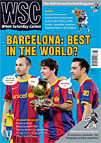 Nick House doesn’t mind that little has changed at Torquay Utd’s home ground and thinks plenty has improved in the last 25 years
Nick House doesn’t mind that little has changed at Torquay Utd’s home ground and thinks plenty has improved in the last 25 years
If 1986 was one of English football’s low points, it’s even more starkly remembered at Plainmoor where Torquay United were in the process of finishing bottom of the pile for the second year running.
Plainmoor itself was typical of many lower-division grounds: a main stand dating from the club’s elevation to the Football League, a covered terrace funded by supporters in the 1950s, an “end” representing the new terrace culture of the late 1960s and an away section offering less comfort than Newton Abbot cattle market. Indeed, there wasn’t much left after the capacity had shrunk from 20,000 to an administratively convenient 4,999. The spirit of the crowd was “hard-core sullen” and a betting person wouldn’t have put money on the club surviving much longer.
Astonishingly it soon became even harder to watch football at Torquay. Away fans, when they came, frequently took advantage of Saturday evening kick-offs by spending the day in pubs by the harbour. Wolves did so with some aplomb in late 1986 and overnight it became Luton-by-the-Sea with compulsory membership cards and restrictions on visiting supporters.
Then, after the closest of brushes with the Conference, matters improved on the pitch. Crowds increased and younger people started to follow the club again. We slowly rediscovered the lost arts of singing and going to away matches in reasonable numbers. Eventually we even embraced the newer aspects of football culture with a fanzine or two and some curiously wingless inflatable sea birds.
If the fans were changing, it took longer for club and ground to follow suit. The club had experienced a damaging Dave Webb-shaped tornado during the mid-1980s but were now back in the possession of an old-style, small-town board: staid, reluctant and bogged down. By 1990, maybe as a sign of the game’s gradual revival, it was in the hands of a “tycoon” who had a plan. He also had access to post-Hillsborough money to improve the ground with an all-seat stand, followed by two new standing areas. This meant three-quarters of the ground was new by 2000, albeit with a capacity of just 6,000.
And that’s how the ground remains in 2011 with the main stand – hawked from Buckfastleigh race course in the 1920s – being due for replacement later this year. Looking back, it now seems that much of the real change in football spectating, at Plainmoor and elsewhere, occurred during a relatively brief spell during the late 1980s and early 1990s. For sure, Torquay’s playing fortunes have fluctuated over the years – there was certain inevitability about relegation to the Conference – as has ownership. But, for good or bad, going to football at Plainmoor is largely unchanged from the mid-1990s.
There’s a bit more available in the way of food, the club does a good pre-match carvery, and there are now steak and ale pies to supplement the pasties. “Matchday entertainment”, as we must call it, has never quite matched the spectacle of long ago when cannonballs were once fired into some chap’s midriff. Ideas come and go but it’s generally at the level of a pleasant village fête.
The current taste is for a half-time “crossbar challenge”, which mainly proves most fans can’t play football for toffee, and the occasional female singer for the bigger games. There’s also the odd business of youth team players being deployed to all corners of the ground to wave flags throughout the game. Sadly, however, after 40 years, the Tannoy no longer plays Herb Alpert’s A Banda. But, all in all, it’s Plainmoor and we rather like it that way.
As for the supporters, compared with 1986, we are more plentiful and upbeat but remain relatively few in number and easily prey to discontentment. Although we may be a little younger (on average) we still look an ageing bunch in the half-light of a Tuesday evening. Nonetheless we have our moments of generating atmosphere and we’ve even got a flag – specially designed to fit the limited dimensions of the Popular Side – together with a number of fans who are striving to create an ultras (or, as has been suggested, “Gulltras”) following.
Meanwhile, the rest of us are either totally wired up, or wholly oblivious, to internet forums which serve to make us more gossipy and “informed” than in the past. Such forums often fuel stuff, nonsense – and even division – but, at smaller clubs anyway, they have the potential to bring people together almost in the fashion of those 1950s whist drives at the Co-operative Hall.
Overall, 25 years on from ID cards, it hardly goes without saying there’s less hassle and grief about going to the football. It’s also a case that, generally speaking, we enjoy the company of away supporters more than we once did (although the nine from Lewes were rather reserved). It’s worth noting Plainmoor was one of the first grounds to switch from policing to stewarding. When we berate the stewards for telling us not to stand on the yellow lines or for coming from Plymouth, we would do well to remember how this aspect of football-watching has progressed from the 1980s.
From WSC 292 June 2011